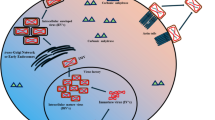Abstract
In this article we report the cloning and expression of a cDNA encoding Tachypleus anti-lipopolysaccharide (LPS) factor, which is of interest for use as a potential inhibitor of the common core subunit of Gramnegative bacterial endotoxins. First, two degenerate primers were designed based on the sequence homology of anti-LPS factors purified from different species of horseshoe crab. The total RNA was extracted from amebocytes of Tachypleus tridentatus. The cDNA was then obtained by using the RT-PCR methods. Second, the cDNA of Tachypleus anti-LPS factor (TALF) was expressed in Bombyx mori larvae using baculovirus expression system, which showed a yield of up to 600 mg/L. Last, we determined the biological activity of the recombinant proteins by LPS neutralization assay and bacteriostatic assay in vitro.
Similar content being viewed by others
References
Freudenberg, M. and Galanos, C. (1990) Bacterial lipopolysaccharides: structure, metabolism, and mechanisms of action. Int. Rev. Immunol. 6, 207–221.
Elsbach, P. and Weiss, J. (1995) Prospects for use of recombinant BPI in the treatment of Gram-negative bacterial infections. Infect. Agents Dis. 4, 102–109.
Tanaka, S., Nakamura, T., Morita, T., and Iwanaga, S. (1982) Limulus anti-LPS factor: an anticoagulant which inhibits the endotoxin mediated activation of Limulus coagulation system. Biochem. Biophys. Res. Commun. 105, 717–723.
Morita, T., Ohtsubo, S., and Nakamura, T., et al. (1985) Isolation and biological activities of Limulus anticoagulant (anti-LPS factor) which interacts with lipopolysaccharide (LPS). J. Biochem. (Tokyo). 97, 1611–1620.
Aketagawa, J., Miyata, T., and Ohtsubo, S., et al. (1986) Primary structure of limulus anticoagulant anti-lipopolysaccharide factor. J. Biol. Chem. 261, 7357–7365.
Muta, T., Miyata, T., Tokunaga, F., Nakamura, T., Iwanaga, S. (1987) Primary structure of antilipopolysaccharide factor from American horseshoe crab, Limulus polyphemus. J. Biochem (Tokyo). 101, 1321–1330.
Nakamura, T., Tokunaga, F., Morita, T., and Iwanaga, S. (1988) Interaction between lipopolysaccharide and intracellular serine protease zymogen, factor C, from horseshoe crab (Tachypleus tridentatus) hemocytes. J. Biochem (Tokyo). 103, 370–374.
Desch, C.E., O’Hara, P., and Harlan, J.M. (1989) Antilipopolysaccharide factor from horseshoe crab, Tachypleus tridentatus, inhibits lipopolysaccharide activation of cultured human endothelial cells. Infect. Immun. 57, 1612–1614.
Warren, H. S., Glennon, M. L., Wainwright, N., et al. (1992) Binding and neutralization of endotoxin by Limulus antilipopolysaccharide factor. Infect. Immun. 60, 2506–2513.
Alpert, G., Baldwin, G., Thompson, C., et al. (1992) Limulus antilipopolysaccharide factor protects rabbits from meningococcal endotoxin shock. J. Infect. Dis. 165, 494–500.
Karl, M. and Arthur H. M. (1994) Insect Cell Biotechnology, CRC, Boca Raton, Ann Arbor London, Tokyo.
Schägger, H. and von Jagow, G. (1987) Tricine-sodium dodecyl sulfate-polyacrylamide gel electrophoresis for the separation of proteins in the range from 1 to 100 kDa. Anal. Biochem. 166, 368–379.
Tomasz, A. (1986) Penicillin-binding proteins and the antibacterial effectiveness of β-lactam antibiotics. Rev. Infect. Dis. 8, 260–278.
Morrison, D. C., and Bucklin, S. Z. (1996) Evidence for antibiotic-mediated endotoxin release as a contributing factor to lethality in experimental Gram-negative sepsis. Scand. J. Infect. Dis. Suppl. 101, 3–8.
Carmeli, Y., Troillet, N., Karchmer, A. W., and Samore, M. H. (1999) Health and economic outcomes of antibiotic resistance in Pseudomonas aeruginosa. Arch. Intern. Med. 159, 1127–1132.
Roopashree, S. D., Chai, C. Ho, B., and Ding, J. L. (1995) Expression of Carcinoscorpius rotundicauda factor C cDNA. Biochem. Mol. Biol. Int. 35, 841–849.
Author information
Authors and Affiliations
Rights and permissions
About this article
Cite this article
Wang, DN., Liu, JW., Yang, GZ. et al. Cloning of anti-LPS factor cDNA from Tachypleus tridentatus, expression in Bombyx mori larvae and its biological activity in vitro. Mol Biotechnol 21, 1–7 (2002). https://doi.org/10.1385/MB:21:1:001
Issue Date:
DOI: https://doi.org/10.1385/MB:21:1:001




